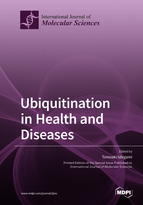Ubiquitination in Health and Diseases
A special issue of International Journal of Molecular Sciences (ISSN 1422-0067). This special issue belongs to the section "Biochemistry".
Deadline for manuscript submissions: closed (31 March 2020) | Viewed by 76218
Special Issue Editor
Interests: hypertension; salt sensitivity; tubular transport; epithelial sodium channels; ubiquitination; Nedd4-2 and atherosclerosis
Special Issues, Collections and Topics in MDPI journals
Special Issue Information
Dear Colleagues,
Ubiquitination is a representative, reversible biological process for the post-translational modification of various proteins with multiple catalytic sequences including ubiquitin itself, the E1 ubiquitin-activating enzymes, the E2 ubiquitin-conjugating enzymes, and the E3 ubiquitin ligase and deubiquitinating enzymes. Since the ubiquitin–proteasome system plays a pivotal role in various molecular life phenomenon such as cell cycle control, protein quality control, and cell surface expression of ion transporters, its failure causes various diseases such as cancer, neurodegenerative diseases, cardiovascular diseases, and hypertension. Actually, various genetic diseases derived from abnormalities in genes involved in ubiquitination have been reported, such as Parkinsonism, Cushing disease, and Liddle syndrome. Ubiquitination is a post-translational modification of proteins subsequent to phosphorylation, and approximately 40% of the proteins encoded by human genes undergo this modification. Although clinical applications targeting ubiquitination are still limited compared with those directed to kinase systems such as tyrosin kinases, for which an inventory of tyrosine kinase inhibitors is already available in clinical settings, many compounds affecting ubiquitination and presenting high pharmacological activity have been identified at the basic research level; therefore, future developments can be expected. Abnormalities of E3 ubiquitin ligase affect the phenotypes specific to each target substrate, which, thus, are also attractive targets for selective drug discovery. In this Special Issue of the International Journal of Molecular Science, we would like to invite your contributions in the form of either original research articles or reviews, which addresses the expanding field of mechanic, functional and pharmacological dissections about the physiological and pathological implications of specific ubiquitination reactions.
Assoc. Prof. Tomoaki Ishigami
Guest Editor
Manuscript Submission Information
Manuscripts should be submitted online at www.mdpi.com by registering and logging in to this website. Once you are registered, click here to go to the submission form. Manuscripts can be submitted until the deadline. All submissions that pass pre-check are peer-reviewed. Accepted papers will be published continuously in the journal (as soon as accepted) and will be listed together on the special issue website. Research articles, review articles as well as short communications are invited. For planned papers, a title and short abstract (about 100 words) can be sent to the Editorial Office for announcement on this website.
Submitted manuscripts should not have been published previously, nor be under consideration for publication elsewhere (except conference proceedings papers). All manuscripts are thoroughly refereed through a single-blind peer-review process. A guide for authors and other relevant information for submission of manuscripts is available on the Instructions for Authors page. International Journal of Molecular Sciences is an international peer-reviewed open access semimonthly journal published by MDPI.
Please visit the Instructions for Authors page before submitting a manuscript. There is an Article Processing Charge (APC) for publication in this open access journal. For details about the APC please see here. Submitted papers should be well formatted and use good English. Authors may use MDPI's English editing service prior to publication or during author revisions.
Keywords
- ubiquitination
- E1 ubiquitin-activting enzyme
- E2 ubiquitin-conjugating enzyme
- E3 ubiquitin ligase
- Deubiquitinating enzyme
- Ubiqutin-proteasome system
- Drug discovery







